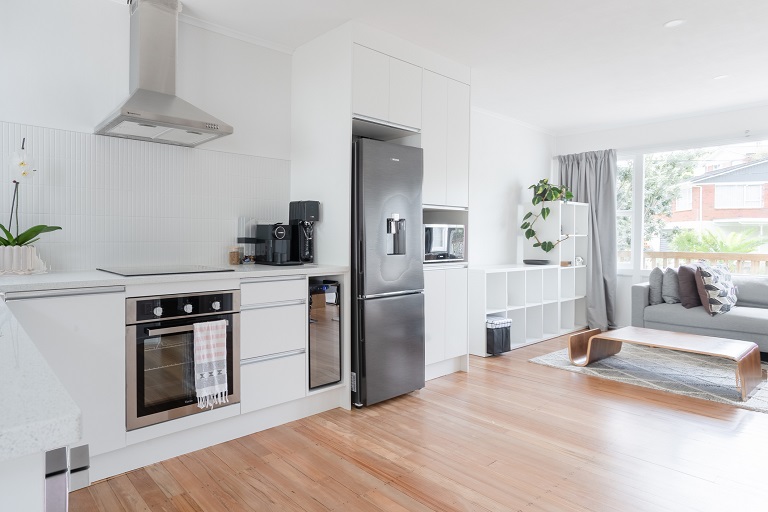What is Engineered Wood For Home Use?
Installing engineered wood can save money and hassle when it comes to DIY projects


Engineered wood consists of planks of plywood topped with real hardwood, albeit a thin layer, that is finished with clear acrylic. This style of hardwood flooring offers the look of solid hardwood, often for a fraction of the price. It’s also easy to install, making it a good option for DIY home renovations.
What is Engineered Wood?
It might sound like something crafted in a lab, but engineered wood bears characteristics of both solid hardwood and laminate flooring. Engineered wood consists of layers, typically arranged as follows:
The top layer is a clear acrylic coating for protection.
Just underneath that is a thin layer of real, solid hardwood.
The base layer is usually also solid hardwood.
Between these two layers of hardwood, you’ll find several layers of veneer or plywood with the grain facing separate directions to provide better stability.
Comparing Engineered Wood, Solid Hardwood, and Laminate
Today, engineered wood and laminate can look deceptively like solid hardwood. But their materials mean these three flooring styles can vary in durability, cost, and ease of installation. Here are the major differences between each type of flooring.
Engineered Wood
This type of wood flooring is made up of layers. Engineered wood features multiple layers of plywood sandwiched between two thin layers of hardwood. It has similarities to both solid wood and laminate.
Solid Hardwood
Solid hardwood is just that: real, solid planks of wood. It’s a durable option, at upwards of 100 years, although it doesn’t hold up to moisture as well as engineered wood. It can also be more expensive and difficult to install without professional help when compared to engineered wood or laminate.
Laminate
On the surface, engineered wood sounds similar to laminate. While they are alike, they also have notable differences.
Laminate is also made of layers, including a backing layer for moisture protection and a base layer made of high-density fiberboard. The biggest difference between laminate and engineered wood? The surface. Unlike engineered wood’s real-wood top layer, laminate instead features a high-resolution image layer that mimics the look of natural wood and a wear layer for protection against scratches, stains, and scuffs.
Laminate is an affordable, easy-to-install option, but its lack of real hardwood means it’s often less durable than its solid or engineered wood counterparts.

Pros and Cons of Engineered Wood Flooring
Engineered wood flooring wasn’t necessarily made to serve as a less costly alternative to solid hardwood. While it is sometimes cheaper, there are several benefits and drawbacks to choosing this type of wood flooring.
Pros of Engineered Wood
Engineered wood can cost about $2.50 to $10 per square foot, which can occasionally be cheaper than the $8 to $15 per square foot cost of solid wood.
A huge benefit to engineered wood is that it has better resistance to warping. Because the plywood core is so stable, it can stand up to humidity and damp mopping better than solid hardwood.
If you are installing over a concrete subflooring, engineered wood is also the best choice because of its durability and easy installation.
Speaking of easy installation, you can add engineered hardwood in several different ways, including nails, floating, or glue. Choose the option that is best and easiest for you (and your floors).
Radiant heating warms up your floors during chilly weather. No more cold feet! Luckily, engineered wood can typically withstand the temperature changes that come with radiant heating. If radiant floor heating is something you want in your home, engineered wood is a good choice.
Cons of Engineered Wood
While it is durable for the relatively short-term, engineered wood has a lifespan of 20 to 40 years. However, if you care for solid hardwood properly, it has a lifespan of up to 100 years.
Because engineered wood has just a thin layer of hardwood on top, it can usually only withstand one refinishing in its lifetime.
Engineered hardwood is not immune to scratching and denting. Its core might be durable, but the thin hardwood surface can fall victim to heavy furniture or toys hurled across the room.
Some manufacturers use products with volatile organic compounds (VOC) to bond the many layers together. The use of VOCs can lead to toxic off-gassing. If this is a concern to you, be sure to search for VOC-free, low-VOC, or formaldehyde-free options.
How to Install Engineered Wood Flooring
Easy installation is a top benefit of engineered wood floors. Like solid hardwood, they can be nailed down. Many manufacturers offer click-and-lock or floating options that make installation simple for DIYers. They can also be glued down.
Maintenance and Longevity of Engineered Wood
Well-cared-for engineered wood can offer many years of use. Like solid hardwood, engineered wood benefits from adding a fresh topcoat of acrylic every few years. While it is more resistant to warping, keep moisture exposure to a minimum to make the most of engineered wood. By caring for your engineered wood floor properly, it can last up to 40 years.
Cost of Engineered Wood Floors
The final price tag on engineered wood flooring can vary. Some manufacturers can use very thin hardwood as the top layer and cheaper plywood for the core. This means a lower cost, closer to $2.50 per square foot, but this also means the flooring might not last as long. High-quality engineered wood contains better materials in every layer, but this means the cost might be akin to the cost of solid hardwood and upward of $14 per square foot. However, chances are it will last longer.














